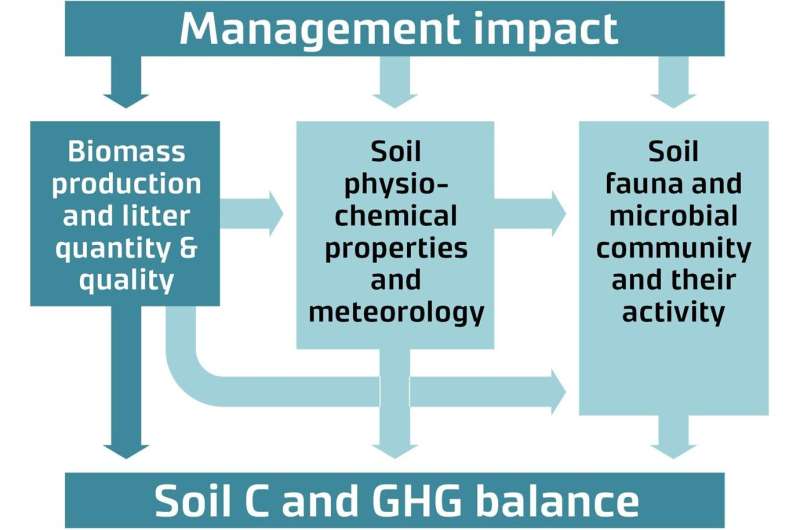This article has been reviewed according to Science X's editorial process and policies. Editors have highlighted the following attributes while ensuring the content's credibility:
fact-checked
peer-reviewed publication
proofread
Forest soil to be included in forest management guidelines and forestry subsidies

Forest soil is a larger carbon storage than trees, and forest management affects soil greenhouse gas (GHG) emissions and carbon sinks. A publication by the international HoliSoils project emphasizes that the European forest sector needs a comprehensive understanding of the carbon sequestration potential of soils. This will help design climate change mitigation measures.
Global studies on forest carbon sinks often focus on wood biomass, wood product sinks or various offsetting effects. Analyses of soil carbon sequestration potential have largely focused on afforestation or avoiding deforestation. Current tools and scenario analyses used to support decision making focus on the carbon sinks of growing trees.
"The impact of forest management on soils is less studied and is treated in a highly simplified way in decision-making, even though forest management is crucial for achieving carbon neutrality objectives for terrestrial ecosystems. Soil is the largest carbon storage in the forest, and it can be either a large sink or a source of GHGs, which are affected by forest management decisions," says research professor Raisa Mäkipää from the Natural Resources Institute Finland (Luke).
Prof. Mäkipää and her international research team wrote a research article on the effects of forest management practices on soil carbon stocks and greenhouse gas emissions. The article, which was published in Forest Ecology and Management as part of the HoliSoils project, involved a total of 30 researchers from Europe and Japan.
The choice of tree species and silvicultural practices have a major impact on soil emissions
Soil is a source of GHGs in drained peatlands. Emissions are higher in areas where the soil is rich in nutrients and where drainage has caused drawdown of the water table level. In drained peatlands, soil emissions increase very significantly after clear-cutting. In nutrient-rich peatlands, soil emissions continue throughout the growth cycle and are greater than the carbon sink of the trees.
"However, organic soil emissions can be reduced through forest management, restoring water regime optimizing both tree growth and peat decomposition, and management on mineral soils should sustain carbon sinks over time to help meet climate goals," Prof. Mäkipää reflects.
Soil carbon stocks are usually lower in deciduous forests than in coniferous or mixed forests, because deciduous forests tend to have lower growth and biomass production than coniferous forests and because deciduous woody debris is more easily degradable and stimulates the activity of soil organisms.
In the mineral soils of the northern coniferous forest zone, nitrogen fertilization increases soil carbon stocks. In mineral soils, the soil carbon stock decreases after clear-cutting, especially in the organic layer. Tillage during reforestation can increase the rate of organic matter decomposition, but better seedling stand growth and higher litter yield can compensate for the carbon released during decomposition. The slower the regeneration of the clear-cut area and new growth takes to get going, the longer it will take for the soil to turn back into a carbon sink. Soil carbon stocks will start to increase 10–50 years after clear-cutting.
Forest management guidelines and forestry subsidies to be reformed
The forest sector needs a holistic understanding of soil carbon sequestration potential. Information that only considers tree cover can lead to ineffective climate policy and suboptimal use of resources in designing mitigation measures. Increasing research knowledge on the effects of forest management on soil carbon sinks and GHG emissions needs to be linked to models used to support planning and decision-making.
"Forest management practices must be made climate resilient. Clear-cutting and drainage of spruce-drained peatlands should be avoided wherever possible. On grasslands, moderate thinning to maintain the growth of the seedling stand, coniferous domination, and increasing the rotation period strengthen the carbon sink, and rapid regeneration after clear-cutting curbs the decline in soil carbon stocks," Prof. Mäkipää recommends.
Forest policy and management should be based on the latest scientific knowledge on soil emissions and carbon sequestration potential. The importance of soil should be included when updating forest management guidelines and when renewing forestry subsidies.
The impact of forestry practices on soil and climate change mitigation
Tree species selection, harvesting practices, nutrients addition, fire risk management, hydrological restoration of peatlands and biodiversity conservation can mitigate climate change.
- Forest management must consider regional differences. The impact of silvicultural management on soil depends on the intensity of silvicultural treatment, soil type (organic/mineral soil) and soil conditions (nutrients, moisture, pH), topography, vegetation composition, climatic conditions, and recovery time after management.
- Selection of tree species considering site-specific conditions, can increase soil carbon stocks. The tree species favorable to the area can increase forest productivity and the amount of dead organic matter transferred to the soil.
- Frequent and light thinning maintains the density of the forest stand. Continuous cover forestry produces relatively steady tree growth and steady litterfall accumulates soil organic matter. Heavy thinning and clear-cutting, on the other hand, reduce soil carbon stocks after felling.
- In the northern coniferous forest zone, nitrogen fertilization of mineral soils and wood ash fertilization of peatlands with high forest cover increases both forest productivity (trees, undergrowth vegetation) and soil carbon stocks, as the amount of litter produced and released to the soil increases.
- Reducing woody biomass and preventing the growth of undergrowth vegetation in Mediterranean forests can reduce soil carbon loss from forest fires.
- In drained peatlands with trees, maintain high water table and avoiding clear-cutting will reduce GHG emissions.
More information: Raisa Mäkipää et al, How does management affect soil C sequestration and greenhouse gas fluxes in boreal and temperate forests?—A review, Forest Ecology and Management (2022). DOI: 10.1016/j.foreco.2022.120637
Journal information: Forest Ecology and Management
Provided by Natural Resources Institute Finland

















